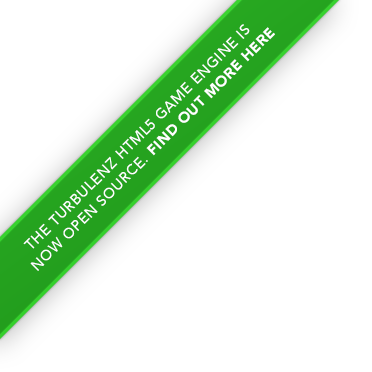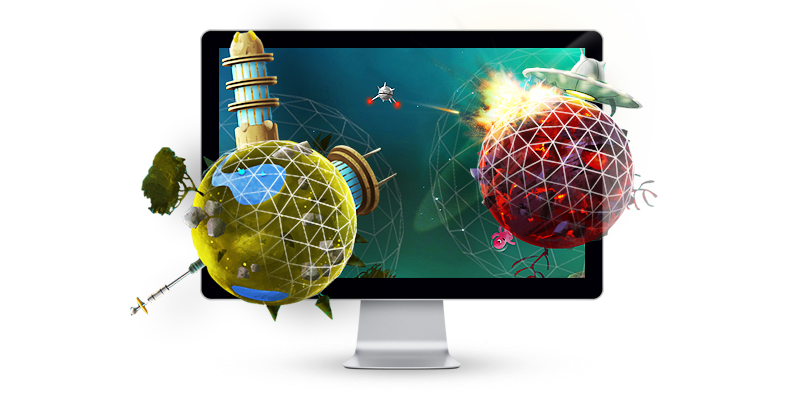
your game with Turbulenz free of charge



The engine libraries are implemented in optimised JavaScript supporting rapid iteration of game code and data. The engine executes directly in the browser and includes some of the following features:
Asynchronous resource loading and swapping; Lazy evaluation of scene updates; Multi-threaded evaluation and execution
Shader based immediate mode dispatch; Supporting multi-technique, multi-pass, multi-materials; Dynamic vertex, index, and texture buffer processing; Deferred rendering supporting unlimited lights; Pluggable POST effects and collection of effects; Exponential shadow maps and occlusion queries; Extensive particle and effect systems; GUI/HUD system supporting multiple fonts and languages
Rigid bodies, Collision primitives and constraints; Ray and convex sweep queries; Large collection of built-in animation controllers; Skeleton animation with quaternions
3D sound sources and up to 7.1 surround sound; Multi-threaded streaming and mixing; Access to HID, allowing external controllers and peripherals
Compression, encryption, reliable and unreliable messaging; Network lag compensation, server/client and p2p architecture; Integration with popular social networks including Facebook; Automatic player sign-in and access automatically handled
Visibility queries via portals, frustum, or overlapping box; Sorting and grouping for visibility and optimal rendering; Bandwidth and hardware scaling by dynamic asset selection
The SDK contains everything a developer needs to rapidly get their project going, polished and deployed, including:
A complete version of the JavaScript Engine code is available for developers to browse and use during debugging. The Engine is completely modular allowing developers to select exactly what features they want to use, and modify or replace anything that isn't suitable for their game.
The SDK includes a wide range of feature and code samples. The aim of these samples is to cleanly demonstrate to developers how to use all the different parts of the game engine. All of the code is fully documented and explained, and suitable to paste into your own project as a starting point for getting a new feature implemented.
A complete set of the latest documentation is distributed in the SDK. The documentation contains an API reference for every API in the Engine, all of the online game services, a user guide for all of the major components, and most importantly an extensive getting started guide.
The Local server replicates all the APIs provided by the live game servers. This allows developers to build their game and correctly use the social web service APIs. The server also implements a local environment for creating a multiplayer game. The Local server also contains a range of tools to help developers analyse and optimise their application. The server reports metrics for all assets requested and is critical to making loading efficient.
Built into the Local server are a collection of tools for debugging the game and assets. The Viewer allows you to quickly preview and manipulate assets. Alongside the Viewer is a dynamic Disassembler that is useful when digging into assets. The Disassembler is designed to help developers quickly pick through any size asset and search for potential issues.
We don't believe in monolithic tools and so all tools are provided as a toolbox. Turbulenz is designed to fit into your existing pipelines and processes. The asset processing tools can convert source assets into the JSON format used by the engine.
All tools needed to prepare, package and deploy your game for to the Turbulenz Developer Hub. The tools can be added to your built process so that the output from every build is playable online.
Can I alter and modify the Turbulenz Engine?
Can I use the Turbulenz Engine with other frameworks?
Can I use my own servers, hosting and services?
Can I use my own or a 3rd party multiplayer service?
Can you help me publish my game?
Can I create a Facebook game with the Turbulenz Engine?
Can I publish games made with the Turbulenz Engine on Spil or Kongregate or ... ?
Can I publish games on turbulenz.com or ga.me?
What does it cost to publish games on turbulenz.com or ga.me?
Can I use the Turbulenz Engine to create a totally free game?
Can I use the Turbulenz Engine for educational projects?
Can I use the Turbulenz Engine for anything else?
Can I use the Turbulenz Engine to create a native game for iOS and Android?
What platforms does the native bundling support?
I don't want to or can't use the open source license, is there an alternative?
Where can I get support using the engine?
We need professionally help and consultancy using the Turbulenz Engine, can you help?